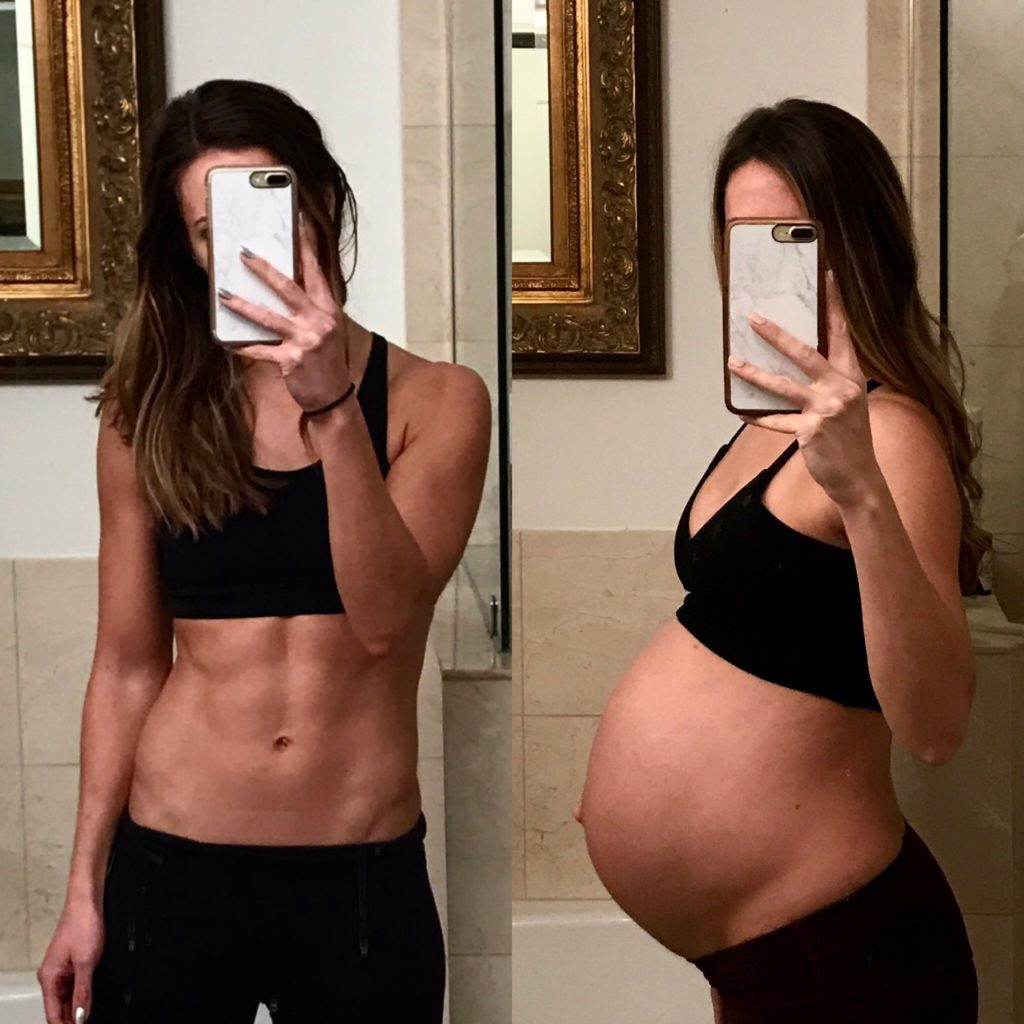The Role of Cardio in Perinatal Fitness

Have you ever wondered how to manage your cardio during your perinatal journey? Whether you’re trying to conceive, are pregnant, or have delivered a baby, there is a lot of conflicting information about what’s considered safe.
Read on for a complete breakdown of what cardio actually is, and how it fits into your perinatal fitness protocol.
The Caveat
Before we go any further, I’ll make the same caveat I always make when writing about perinatal fitness on this site. EVERYTHING IS RELATIVE and unique to the individual. My M.O. comes from evidence-based, best practice, and honestly, I err on the CONSERVATIVE side. So please don’t @ me and ask, “what about what XYZ trainer/influencer says?” Because I don’t speak for them, I only speak for myself. The following are my beliefs surrounding perinatal cardio management
My OFFICIAL point of view:
Just because you can do it, or have done it in the past, doesn’t mean you should execute that same method of fitness TODAY.
Let that sink in.
Just because you can do it, or have done it in the past, doesn’t mean you should execute that same method of fitness TODAY. And that’s not to say you’ll never do that same method again. It may just not be right for you, RIGHT NOW.
Regardless of your stage or season of life, you don’t work out for the moment; you work out for the future, and with that comes an ever-evolving protocol that accounts for longevity. Sure, you may have run 25 miles per week every week when you were in your 20’s, but that doesn’t mean you have to in your 30’s, and it doesn’t mean you should do it while you were pregnant just because that’s what you’ve always done.
You know? Your training will ebb and flow, just like your life.
That’s my opinion. So if you’re looking for someone to tell you it’s okay to do 1,000 crunches and burpees in your third trimester just because you’ve done it since college, this may not be the place for you. No shade or judgment tho!
Likewise, if you’re looking for a list of what to do vs. what not to do, unfortunately, this isn’t it. And actually, I would be wary of any “good or bad” list if you ever come across one because it’s not really WHAT you do, it’s how you do it, and how you do it will be unique to YOU.
The Role of Cardio in Perinatal Fitness
Every woman and pregnancy is different, but in 2020 it is accepted by the medical community that women proficient in exercise before pregnancy can exercise during pregnancy. Furthermore, most of the medical community will agree that being inactive during your pregnancy is (generally speaking) more harmful and problematic for both the mother and baby than a pregnant woman executing a safe and thoughtful program.
Any exercise (cardio or otherwise) can be unsafe if your form is shit. And that’s just some real talk, so it’s imperative to be mindful. Especially during pregnancy and early postpartum life – which is actually really challenging because you will feel like you’re a stranger in your own body. Your center of gravity is off, your range of motion will change, and your perceived exertion will be through the roof. It’s wild.
The following information isn’t going to categorize cardio into “safe” and “unsafe.” Still, it will give guidance on how to SMARTLY execute your cardio-based fitness protocol throughout all stages of your pregnancy: trying to conceive (TTC), during pregnancy, and in postpartum life.
What is Cardio?
First things first, can we align on what cardio actually is?
Cardio = cardiovascular = aerobic exercise = with oxygen
Performed by repeatedly moving the muscles in your arm, legs, and hips, in turn increasing heart rate and breath and maximizing the amount of oxygen in your blood.
It is MORE than just running! So many conversations in my DM’s start and end with running, and I’m here to tell you if you love it, do it. If you don’t, NO WORRIES, there are literally so many other ways you can workout.
Regardless, just about every type of cardio is unilateral, meaning the better or faster you are, the more coordination and strength you’ll need. Hold that thought; I’ll circle back to this thought.
Cardio While Trying to Conceive
If you aren’t pregnant and are hoping to become pregnant, your actions today can impact your future health and that of your baby. Again, it is widely accepted that any physical activity is better than no physical activity, regardless of who you are and your season of life, and that follows suit for a woman trying to conceive.
Any google search may result in studies or articles concluding exercise can impact fertility; however, for the general population, the extreme levels those studies or articles discuss aren’t necessarily a concern. At the very least, exercise will improve your mood, quality of life, and wellbeing. So while there isn’t necessarily a protocol that is scientifically proven to improve fertility (remember correlation does NOT always equal causation), there is no time like the present to improve your health.
If you’re new to your fitness journey, start here.
Cardio While Trying to Conceive via IVF
If you are trying to conceive with the help of IVF or other medical intervention, you will NEED to listen to the guidance and advice from a practitioner. Often, that will include the need to stop exercising altogether for some time. For example, IVF requires a cocktail of daily injections that will cause your ovaries to swell. A level of impact (from exercise) can cause ovarian torsion (a twisting of the ovary around the ligament that holds it in place, thus cutting off blood flow) or other medical emergencies.
Additionally, drugs, retrieval, and transfers are STRESSFUL. And as high as exercise can take you, it does contribute to stress on the body. If your practitioner tells you to take it easy, you should 100% listen.
Cardio While Pregnant
Remember when I said, just about every type of cardio is unilateral, meaning the better or faster you are, the more coordination and strength you’ll need? Do you know what you DON’T have when you’re pregnant? Coordination. Do you know what you lose while pregnant? Strength. While you are pregnant, regardless of your level of fitness and ability, you will experience a decrease in both.
A growing baby will put pressure on the pelvic floor, which will disturb your movement patterns, the same ones used for most cardiovascular activity. Your body will provide a hormone called relaxin, to accommodate your expanding uterus and prepare your body for birth, which causes your body to relax. Relaxin can give a false sense of flexibility and mobility. Moving faster, stretching further, or lifting heavier with this false sense of confidence can put you at risk for injuries:
- Diastasis recti
- Pelvic organ prolapse
- Pubic symphysis pain
- Low back or hip pain
That last paragraph sounds daunting and fear-based, but I assure you that’s not my tone of voice. And it’s not to say you can’t workout and push yourself while pregnant. Those are facts meant to inform and help you make your own decisions. If you’re in your second trimester running faster than ever, lifting heavier than you ever have, is it because you’ve made incredible gains over the last few weeks? Most likely, no.
Evaluate what you’re doing, how you’re doing it, and remember the goal of your fit pregnancy is to deliver a happy and healthy baby, not PR, you sprint or deadlift. You’ll have the rest of your life to accomplish that.
If you’re pregnant and no longer comfortable running, or are experiencing pain during or after a running workout, why stress? There are SO many other ways to move your body.
- Perinatal pilates
- Strength training
- Walking, or walking on an incline
- Spinning
- Swimming
- Elliptical
- Step Mill
Cardio is not just running on a treadmill; there are so many different ways to move your limbs, strengthen your muscles, and elevate your heart rate. Never forget it!!!!
Old Science: Cardio While Pregnant
The guideline of keeping your heart rate to 140 BMP is about as arbitrary as the 1200 calorie diet. A number spewed by one person MANY years ago that stuck for way too long and is now totally out of context. TBH, I also think the “talk test”(being able to hold a conversation while exercising) is also a bit outdated.
If your practitioner recommends keeping your heart rate below 140, I would ask why, and if they can’t give you a specific answer, I would respectfully push back and ask for a little more information. It’s not necessarily your doctor’s job to understand your chosen workout methodology, it is their job to protect you and your baby, so they may opt to stand by that number in the absence of knowledge about Barry’s, or whatever else you like to do.
Be your own advocate and UNDERSTAND what you’re doing, why, and the end goal. The risk of harming yourself or your baby will NEVER be worth it.
When Should You STOP Exercising?
IMO there is no one guideline for when to stop exercising. So I recommend using common sense!! If you experience any of the below, STOP exercising immediately. Do not “power through” – stop.
- Headaches or dizziness
- Prolonged shortness of breath
- Chest pain
- Leaking urine
- Severe heaviness in the pelvis
- Prolonged pelvic pain
Likewise, if you’re unable to recover and have excessive or prolonged soreness, I’d evaluate your behavior. Think about it. Any injury you receive in pregnancy, you’ll have to rehab afterward, and that adds to your recovery timeline. As I said, I’m conservative, but I also know no one is handing out awards to pregnant chicks slamming weights in the gym. WINK!
Postpartum Best Practice
If you’re like me, the only thing you want after having your baby (after knowing everyone is happy and healthy) is to feel like yourself again. If you’re reading this blog, more than likely, fitness plays a massive role in your health (mental, physical, and emotional) and wellbeing.
While the six-week check-up is somewhat arbitrary, a lot of women wonder, “do I actually have to wait to workout?” The answer is yes. And even more so, question when it’s okay to get back into running. The answer is after you’re able to:
- Confirm vaginal or c-section scar has healed
- Evaluate your pelvic floor health
- Realign your posture
- Regain balance
- Rebuild strength
Does that magically happen at 6-weeks postpartum? No. YOU have some groundwork to do. Read my full guideline for Postpartum Fitness here. And understand some basic principals.
- Any cardio can be unsafe without proper form
- It’s necessary to keep an athletic posture regardless of activity, meaning your back shouldn’t round, and your chest shouldn’t collapse
- If your pelvic floor is tight, sore, or uncomfortable after exercise, that’s most likely a sign your glutes are weak and unengaged.
- If you’re on a machine such as a treadmill, elliptical, or step mill, avoid holding on to the rails, which are often used as a crutch and encourage poor form.
None of that happens overnight! Progress your strength training slowly and consistently, and you’ll be off to a good start.
ARE YOU READY TO RUN AFTER YOU’VE HAD A BABY?
You’re ready for running if you can confidently say YES to MOST of the below:
- You’ve solved any pelvic floor dysfunction. You do not experience pain with sex, leaking, heaviness, incontinence, or diastasis recti
- You don’t experience lower back pain
- Bleeding has stopped
- You can:
- Walk for 30 minutes without pain or discomfort
- Find balance on one leg for 10 seconds
- Jog for 1 minute
- Hop in place on one foot for ten reps without losing balance
- Perform a ‘running man’: opposite arm and hip flexion/extension for ten reps on each side
- You’ve assessed your strength via various unilateral (single-sided) drills
- Calf raise
- Glute bridges
- Sit to stand
- Side-lying abduction
Again, none of this happens overnight. Once you’re cleared for exercise, then you should begin addressing each item above to rebuild your strength to prepare for running as well as progressing your strength training.
If you decide you are NOT ready to run, please ask your OB for a referral and/or order for pelvic floor physical therapy, which will change your rehab for the better, I promise.
In Conclusion
Walking on an incline. Running. Swiming. Cycling. Shit, pushing a stroller for that matter requires so. much. strength. With or without a belly. We tend to forget that. Especially those with an able body or those who have never been injured.
We often take for granted movements such as running and therefore underestimate all that goes into the pattern HEATHILY and SAFELY.
Giving birth is TRAUMATIC. In fact, the level of trauma that goes into delivery is comparable to that of a car accident – TOTALING YOUR CAR. Regaining your strength, form, and body economy will not happen overnight, and it WILL take longer than you expect. But rehabbing and preparing in a holistic and safe matter will put you in the best possible position for the most efficient success. Trust.







Ok